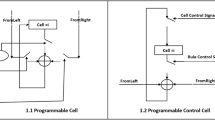Abstract
High-performance pseudorandom number generators (PRNGs) play an important role in a variety of applications like computer simulations, and industrial applications including cryptography. High-quality PRNG can be constructed by employing cellular automata (CA). Advantage of the PRNG that employs CA includes that it is fast and suitable for hardware implementation. In this paper, we propose a two-dimensional (2-D) CA based PRNG. Our scheme uses the structure of programmable CA (PCA) for improving randomness quality. Moreover, for reducing of serial correlations among the produced pseudorandom bits, a consecutive bits replacing spacing technique is proposed. Finally, we provide experimental results to verify the randomness quality using ENT and DIEHARD test suites.
Access this chapter
Tax calculation will be finalised at checkout
Purchases are for personal use only
Preview
Unable to display preview. Download preview PDF.
Similar content being viewed by others
References
M. Matsumoto, “Simple Cellular Automata as Pseudorandom m-sequence Generators for Built-In Self-Test”, ACM Transactions on Modelling and Computer Simulation, ACM Press, New York, 1998, Vol. 8, No. 1, pp. 31-42.
S. Wolfram, Theory and Applications of Cellular Automata: Including Selected Papers 1983-1986, River Edge, NJ: World Scientific, Champaign, 1986.
S. U. Guan and S. Zhang, “A Family of Controllable Cellular Automata for Pseudorandom Number Generation”, International Journal of Modern Physics C, World Scientific Publishing, 2002, Vol. 13, No. 8, pp. 1047-1073.
S. U. Guan, S. Zhang and M. T. Quieta, “2-D CA Variation With Asymmetric Neighborship for Pseudorandom Number Generation”, IEEE Transactions on Computer-Aided Design of Integrated Circuits and Systems, IEEE, 2004, Vol. 23, No. 3, pp. 378-388.
S. Wolfram, “Statistical Mechanics of Cellular Automata”, Review of Modern Physics, APS physics, 1983, Vol. 55, pp. 601-644.
S. Wolfram, “Cryptography with Cellular Automata”, Advances in Cryptology: Crypto ‘ 85 Proceedings, Springer-Verlag, New York, 1985. LNCS 218, pp. 429-432.
S. Nandi, B. K. kar and P. P. Chaudhuri, “Theory and Applications of Cellular Automata in Cryptography”, IEEE Transactions on Computers, IEEE, 1994, Vol. 43, No. 12, pp. 1346-1357.
S. Wolfram, “Random Sequence Generation by Cellular Automata”, Advanced in Applied Mathematics, Academic Press, Orlando, 1986, Vol. 7, pp. 123-169.
P. D. Hortensius, R. D. Mcleod, D. M. Miller and H. C. Card, “Cellular Automata-Based Pseudorandom Number Generators for Built-In Self-Test”, IEEE Transactions on Computer-Aided Design, IEEE, 1989, Vol. 8, No. 8, pp. 842-859.
D. R. Chowdhury, I. Sengupta and P. P. Chaudhuri, “A Class of Two-Dimensional Cellular Automata and Their Applications in Random Pattern Testing”, Journal of Electronic Testing: Theory and Applications, Kluwer Academic Publishers, Norwell, 1994, Vol. 5, No. 1, pp. 67-82.
M. Tomassini, M. Sipper and M. Perrenoud, “On the Generation of High Quality Random Numbers by Two-Dimensional Cellular Automata”, IEEE Transactions on Computers, IEEE, 2000, Vol. 49, No. 10, pp. 1146-1151.
Author information
Authors and Affiliations
Editor information
Editors and Affiliations
Rights and permissions
Copyright information
© 2008 Springer Science+Business Media B.V.
About this paper
Cite this paper
Kang, BH., Lee, DH., Hong, CP. (2008). Pseudorandom Number Generation Using Cellular Automata. In: Sobh, T., Elleithy, K., Mahmood, A., Karim, M.A. (eds) Novel Algorithms and Techniques In Telecommunications, Automation and Industrial Electronics. Springer, Dordrecht. https://doi.org/10.1007/978-1-4020-8737-0_71
Download citation
DOI: https://doi.org/10.1007/978-1-4020-8737-0_71
Publisher Name: Springer, Dordrecht
Print ISBN: 978-1-4020-8736-3
Online ISBN: 978-1-4020-8737-0
eBook Packages: EngineeringEngineering (R0)




